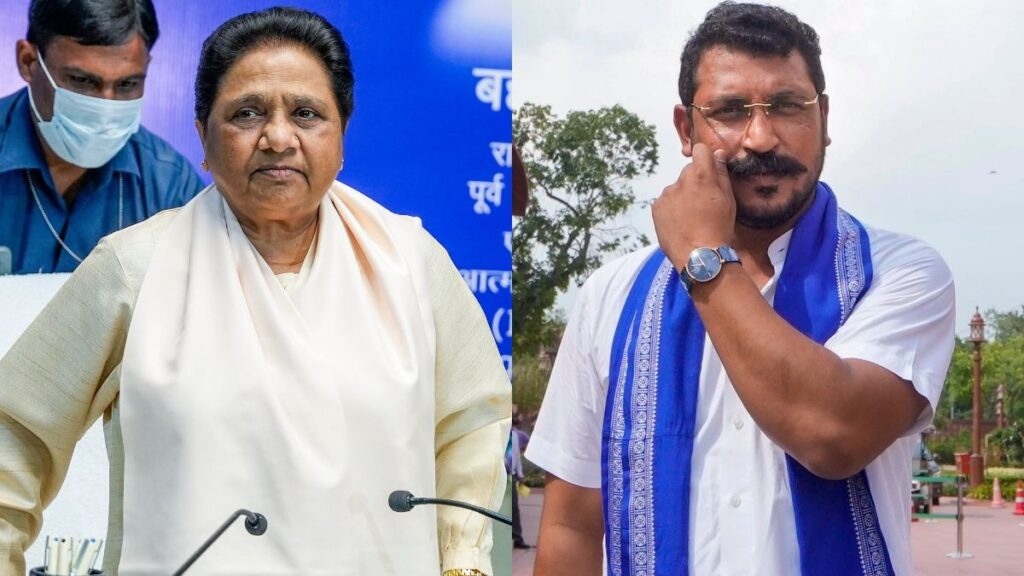The date of Haryana assembly elections has been decided. Although efforts are on to change it, but the Election Commission has not yet expressed its intention on this, but in view of the assembly elections, the political arena in Haryana is ready and as the date of voting is coming closer, the fight for Dalit votes is getting fiercer. With the entry of Bahujan Samaj Party (BSP) and Azad Samaj Party (ASP) in the electoral fray, the contest has become even more interesting.
Alliance in INLD and BSP
Abhay Chautala’s Indian National Lok Dal (INLD) has formed an alliance with Mayawati, while Dushyant Chautala’s Jannayak Janata Party (JJP) is trying to woo Scheduled Caste (SC) voters by joining hands with Chandrashekhar Azad. In this assembly election, INLD will contest on 53 seats, while BSP will contest on 37 seats, including all SC reserved seats. On the other hand, JJP is preparing to contest on 70 seats and ASP on 20 seats.

BSP’s influence in the state has decreased!
Talking about the influence of BSP in Haryana, Mayawati’s party’s influence in the state is decreasing. Its total vote share was 6.7% in 2009, which decreased to 4.2% in 2019. Congress, which is trying to create a social equation of Jat + Dalit + Muslim, is worried that this move may have been taken with the aim of dividing SC votes.
What does the 2011 census say?
According to the 2011 census, the SC population in Haryana is 20.2% of the total population and 17 seats are reserved for this community in the assembly. The SC population in rural areas is 22.5%, while in urban areas it is 15.8%. Fatehabad district has the highest SC population, which is 30.2%.
This is followed by Sirsa at 29.9% and Ambala at 26.3%. The lowest population was recorded in Mewat at 6.9%, Faridabad at 12.4% and Gurugram at 13.1%. Scheduled castes largely supported the India Alliance (Congress+AAP) in the 2024 general election. About 68% of Dalits (+40%) supported the India Alliance, while 24% supported the BJP (-34%). This major shift led to an 8% vote share gain for the India Alliance while a 7% vote share loss for the BJP, leading to a 15% vote swing against the BJP.
As a result, the BJP lost 5 of the 10 seats it had won in 2019. The Congress won both the SC reserved seats in the Lok Sabha elections.

Trend of reserved seats
In the 2009 assembly election, INLD won 9 reserved seats and secured 36% of the votes. Congress won 7 seats and got 40% of the votes, while other parties got just 1 seat. BSP and BJP got 6% and 4% of the votes respectively on these seats. In 2014, BJP won 9 reserved seats, INLD 3 and Congress 4. INLD got 29% of the votes on these seats. Congress got 25%, BSP 3% and BJP 33%. In 2019, BJP won 5 reserved seats, Congress 7 and JJP 4. With this, BJP got 33% votes on reserved seats, Congress 30%, JJP 22%, BSP 3% and INLD got only 1%.
BSP’s influence decreased, but it caused damage to the runner-up
Though the BSP’s influence has diminished, it has hurt the chances of the runner-up in 18 seats where it secured more votes than the margin of victory. It has hurt the Congress’ chances in 7 seats, the BJP’s in 5, the JJP’s in 2 and other parties’ in 4 seats. It will be interesting to see how much of the BSP’s vote share the ASP secures, which could further weaken the BSP in the state. However, in a tight election, the vote share secured by these parties and their role could be crucial.
The Jatavs, the most influential SC group in Haryana, account for almost half of the state’s total SC population. They have more than 10% population in 49 seats. Regionally, 11 of these seats are in Hisar, 9 in Ambala and Rohtak, 8 in Gurgaon, 7 in Faridabad and 5 in Karnal.
In 2009, the Congress won half of these seats, while the INLD won 17. In 2014, the BJP won 27 seats, the Congress 9 and the INLD 8. In 2019, the BJP’s tally dropped to 21 seats, while the Congress increased it to 15 and the JJP won 8. In terms of vote share, the BJP won 43% of the votes, the Congress 31% and others 26%.

Congress’s attempt to form a coalition of Jats, Dalits and Muslims
In the 2024 general elections, the Congress created a social equation of Jats, Dalits and Muslims, who form almost half of the state’s total population. 68% SCs and 64% Jats supported the Congress-AAP alliance. Dalits turned to the All India Alliance due to BJP leaders’ talk of “changing the Constitution”.
Though they voted together in general elections, their relationship has always been strained. In 2010, a Jat mob burned down 18 Valmiki houses in Mirchpur village. In 30 seats, both Jats and Jatavs have more than 10% of the population. In 2019, the BJP and Congress won 9 of these seats each, the JJP 8 and others 4. The Congress hopes to get the support of both Dalits and Jats and win most of these seats.
What does BJP expect?
A section of Dalits is demanding that the Congress should project Kumari Selja as the face of the chief ministerial candidate instead of the Hooda family. The BJP hopes that this factionalism will benefit it. Moreover, the BJP hopes that the INLD and JJP, along with the BSP and ASP, will attract a large section of Dalit voters, thereby neutralising to some extent the gains made by the Congress in the general elections. Interestingly, both the INLD and JJP represent the dominant Jat community, and the BJP hopes that they will cause double damage to the Congress by attracting Jat and BSP/ASP Dalit voters.
Source (PTI) (NDTV) (HINDUSTANTIMES)
